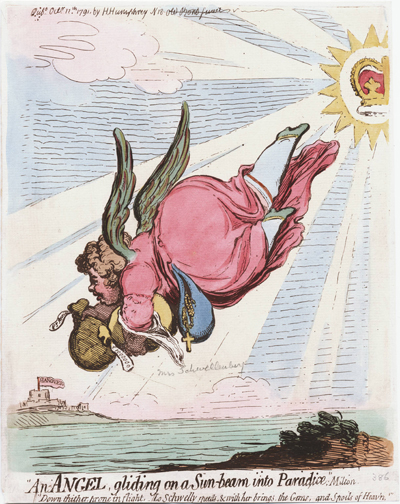An Angel Gliding on a Sun Beam. . .
Borrowing lines from Books IV and V of Milton's Paradise Lost, this print shows the anything but angelic Juliane von Schwellenberg, the long-time confidant and femme de chambre of Queen Charlotte laden with sacks of money labeled "£1000000" per annum." gliding on the sunbeams and favor of (at least) the feminine half of the royal family.* It is one of ten single figure satiric portraits of mostly conspicuous women that Gillray created in September/October 1791 while Parliament was not in session.

© Lewis Walpole Library, Yale Universoty
Madame Schwellenberg was one of two original attendants on the 17 year old Charlotte of Mecklenburg-Strelitz who were allowed to accompany the young Princess from her German homeland to England where she married George III in 1761. Once installed at court, the famously tight-fisted, rude, and controlling Madame Schwellenberg insisted upon being a gatekeeper to the queen, restricting access to her majesty solely to those she allowed.
One of her responsibilities, of which she was inordinately proud, was to have charge of the long box in which the queen's jewels were carried to and from town so that they were always available for drawing room days. Fanny Burney tells of one occasion in 1786 when Mrs Schwellenberg proudly displayed the jewels to a favored equerry, Major Price. (II: 186). This rather presumptuous sense "owning" the Queen's gems is no doubt behind an allusion in the London Oracle for October 20 1789:
Madame Schwellenberg, they say, has written a very pathetic Letter of Condolance (sic) (allowing for some trifling orthographical Errors) to the favourite Woman of the Queen of France most kindly sympathizing with her upon her present Troubles, and advising her by all means to deposit her Jewels in her Custody, till the return of more tranquil times.
And this one, again from the London Oracle, this time from September 18 1789: where once again Madame Schwellenberg is assumed to be motivated by a love of gems.
Madame Schwellenberg has, we hear, expressed a great desire, amid the general rage for acting, to make herself a Theatrical experiment upon the Bristol Stage ; having understood, that one Diamond is the Conductor. If she does, it is evident that Jewel must be the Prompter.
But in 1791, this may have been old news. What was "new," or at least newer was a war of wills between Madame Schwellenberg and Fanny Burney who had become a royal favorite of the queen, but the butt of continual small abuses from Madame Schwellenberg. Burney had joined the Queen's staff as a dresser and companion in 1786. But by the summer of 1791, with her health breaking down, she couldn't stand working with Madame Schwellenberg any longer and insisted upon being released from her duties. Burney's experience was not unique. According to Janice Hadlow, over the years, Schwellenberg provoked a "wearying succession of rows and feuds" with members of the Court. Even the King was often exasperated by her.
The king had always resented her presence, and after yet another explosion in the queen's household, he was reported to 'have desired she should be dismissed, and return to Germany with an allowance suitable to her position in that country.' (Hadlow: P.177)
Court attendants were, in general, generously treated. In the end, Fanny Burney was given £100 per annum pension, when she left the queen's service after only five years. Is Gillray here imagining the (naturally outrageous) "Gems, and Spoils" of her residence in royal heaven that Madame Schwellenberg would consider hers were she actually dismissed by the other half of the crown?
In this instance, as in others, Schwellenberg maintained her hold on the Queen, even against the wishes of the King. She died, still in the Queen's service, in 1797.
* The image of the half crown was probably borrowed from an earlier print by Rowlandson, The Prospect Before Us appearing during the Regency crisis of 1788 which showed a half crown over each of the heads of William Pitt and Queen Charlotte indicating that the king's power would be shared between them.
Sources and Reading
- Commentary from the British Museum on An Angel Gliding on a Sun Beam.
- Draper Hill, Mr. Gillray The Caricaturist, 1965, p. 148n
- "Frances Burney," Wikipedia
- "Charlotte of Mecklenburg-Strelitz," Wikipedia
- "Juliane von Schwellenberg," Wikipedia
- Charlotte Barrett, Ed.Diary and Letters of Madame D'Arblay, Volume 2 London, 1891
- Janice Hadlow, A Royal Experiment, New York, 2015.
- Thomas Wright and R.H. Evans, Historical and Descriptive Account of the Caricatures of James Gillray #386.
- Thomas Wright and Joseph Grego, The Works of James Gillray, the Caricaturist; With the History of His Life and Times, p. 137.
Comments & Corrections
NOTE: Comments and/or corrections are always appreciated. To make that easier, I have included a form below that you can use. I promise never to share any of the info provided without your express permission.